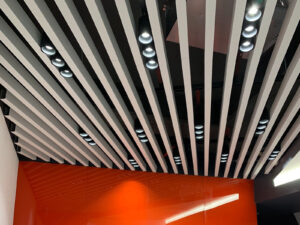What Is a Suspended Metal Ceiling? Benefits, Types, and Applications
A suspended metal ceiling, also known as a metal drop ceiling or metal grid ceiling, is a secondary ceiling structure installed below the main ceiling or roof. It consists of a lightweight metal framework—typically made from aluminum or steel—supporting panels or tiles. These tiles can be perforated, plain, or patterned, depending on the desired aesthetic and acoustic performance.
Suspended metal ceilings are commonly used in commercial buildings, airports, offices, hospitals, and modern homes. They allow for easy integration of lighting, ventilation, and fire safety systems while maintaining a clean, modern appearance.
How Suspended Metal Ceilings Work
The system is built with a metal suspension grid that hangs from the main structural ceiling using adjustable hangers or wires. Once the grid is in place, metal ceiling panels or tiles are laid or clipped into position. The design allows for easy access to electrical and HVAC systems, making maintenance simple and cost-effective.
 Depending on the application, designers can choose open-cell, linear, or clip-in systems. Each type offers a unique visual style and different levels of acoustic and structural performance.
Depending on the application, designers can choose open-cell, linear, or clip-in systems. Each type offers a unique visual style and different levels of acoustic and structural performance.
Benefits of Suspended Metal Ceilings
-
Aesthetic Flexibility:
Metal ceiling tiles come in various finishes—such as brushed aluminum, matte white, or even custom colors—allowing architects to match any interior design theme. -
Durability:
Unlike traditional gypsum or mineral fiber ceilings, metal ceilings are resistant to moisture, fire, and impact, making them ideal for high-traffic or humid environments. -
Acoustic Control:
Perforated metal panels with acoustic backing materials can significantly reduce noise levels, creating comfortable working or living environments. -
Sustainability:
Most suspended metal ceilings are made from recyclable materials, aligning with green building standards such as LEED certification. -
Ease of Maintenance:
The modular design enables quick removal and replacement of tiles for cleaning or maintenance without disrupting the entire ceiling system.
Applications of Suspended Metal Ceilings
Suspended metal ceilings are widely used in airports, shopping centers, hotels, corporate offices, hospitals, and educational institutions. In residential settings, they add a sleek and contemporary look to kitchens, basements, and hallways.
Their ability to integrate seamlessly with lighting, air conditioning, and sprinkler systems makes them a top choice for modern architectural designs that prioritize both function and style.
A suspended metal ceiling offers the perfect balance of durability, aesthetics, and practicality. Whether for a corporate office or a public facility, it enhances both the visual appeal and performance of any space. As more designers embrace sustainable and flexible materials, suspended metal ceilings continue to define the future of modern interior architecture.
